ASUS Eee Pad Transformer Review
by Anand Lal Shimpi on April 21, 2011 4:00 AM ESTI've been on a bit of a tablet kick lately, so even if you have dinner with me—tablets are bound to come up (I only break out the SSD conversation for the truly patient). Last week I had the pleasure of having dinner with Tony Tamasi and Jim Black of NVIDIA, and of course—tablets came up.
I've been thinking about device synergy, something I brought up in our PlayBook review. The problem is as follows: if I'm on my desktop with half a dozen tabs open and perhaps a PDF as well, but I decide to switch over to a tablet—there's no quick way that I can transition my reading environment between the devices. What I have to do is sit down on the couch, whip out my tablet, and manually navigate to each website and redownload/open the PDF. What I'd like to do is something along the lines of HP's Touch to Share, but just on a larger scale.
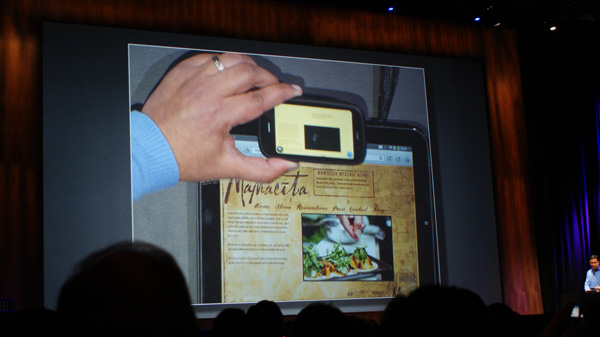
HP demonstrating Touch to Share
I posed this question to Tony when he asked me about future tablet technologies. From Tony (and NVIDIA's perspective), the problem is a non-issue because eventually all computing is done on your smartphone and you simply dock it from one set of input/output devices to the next. At your desk you'll dock your smartphone to a large display, keyboard and mouse. On the go you'll either have your smartphone or dock it into a notebook like chassis. Presumably you'll have a mid-sized display you could tether it to for tablet use as well.
NVIDIA isn't the only company that believes in the future of dockable computing. Earlier this year Motorola released the Atrix, arguably the best overall Android phone on the market today, with an optional laptop dock. While Motorola's docked experience wasn't all that great, treat it as a proof of concept—there's potential here.
You might argue that Motorola's shortcomings with its laptop dock are a result of its unfamiliarity with making PCs; after all Motorola has never shipped a laptop, just smartphones. You might also argue that a PC maker would have an easier time delivering a more polished, functional solution. You might assume that a company like ASUS might be a good candidate for such a thing. You'd be right.
The Eee Pad
ASUS was at the forefront of the netbook revolution thanks to its close partnerships with Intel and Microsoft. ASUS has been all but absent from the smartphone and tablet revolution again, because of its two key partnerships: Intel and Microsoft. Both Intel and Microsoft lay dormant while the smartphone and tablet revolution pick up speed; granted this may all change around Windows 8, but for now it's the truth. If you're a partner of both Intel and Microsoft, you too lay dormant while competitors like Apple, Samsung, Motorola and LG take your cake. After more than enough thumb fiddling, it was ASUS' turn for a slice. The result is this:
Technically it's called the Eee Pad Transformer TF101 thanks to its ability to transform into a netbook/notebook with an optional keyboard dock and ASUS' inability to shy away from long model names. From here on out we'll just call it the Eee Pad.
At a very high level, the Eee Pad is yet another Honeycomb tablet. It's got an NVIDIA Tegra 2 SoC, 1GB of LPDDR2 memory, a WiFi radio, and 16GB of NAND on-board. Delve a little deeper and the story quickly becomes more interesting.
We'll start at the price: $399 for 16GB WiFi. That's $100 cheaper than the equivalent iPad, and $200 cheaper than the lowest priced Xoom. I've often called tablets luxury devices, but ASUS is putting the price pressure necessary on these things for the market to really thrive. While $399 isn't into the "why not?" category just yet, I like where ASUS is headed with this. In other words, I don't believe $399 is the floor here either. Up to now tablets (and smartphones) have been a cash cow for those involved. I don't mind there being premium offerings; I just also want to see something more affordable.
The low price point alone is enough to make the Eee Pad worth considering if you want an Android tablet, but surprisingly enough ASUS didn't sacrifice much in the way of quality to hit it.
The chassis isn't all metal, nor is it soft touch plastic, but that's not to say the feel is bad at all. On the front you've got mostly glass surrounded by a thin strip of metal that wraps around the Eee Pad. Around back there's a textured plastic covering that seems oddly reminiscent of a notebook (the foreshadowing here is quite thick).
The feel is what's most surprising about the Eee Pad. Despite not spending a ton on materials, ASUS managed to build a very comfortable to hold and use tablet. There's a bit of creakyness in the back plastic if you squeeze the Eee Pad, but it's not enough to make the tablet feel cheap. A benefit of not being made of aluminum is I'm not as afraid to set the Eee Pad down on a table as I am the iPad. It feels more rugged, more casual.
| Tablet Specification Comparison | ||||||
| Apple iPad 2 | ASUS Eee Pad | BlackBerry PlayBook | Motorola Xoom | |||
| Dimensions | 241.2mm x 185.7mm x 8.8mm | 271mm x 175mm x 12.95mm | 194mm x 130mm x 10mm | 249.1mm x 167.8mm x 12.9mm | ||
| Display | 9.7-inch 1024 x 768 | 10.1-inch 1280 x 800 | 7-inch 1024 x 600 | 10.1-inch 1280 x 800 | ||
| Weight | 601g (WiFi only) | 675g | 425g | 730g | ||
| Processor | 1GHz Apple A5 (2 x Cortex A9) | 1GHz NVIDIA Tegra 2 (2 x Cortex A9) | 1GHz TI OMAP 4430 (2 x Cortex A9) | 1GHz NVIDIA Tegra 2 (2 x Cortex A9) | ||
| Memory | 512MB | 1GB | 1GB | 1GB | ||
| Storage | 16GB up to 64GB | 16GB + microSD card | 16GB up to 64GB | 32GB + microSD card | ||
| Pricing | $499 up to $829 | $399 | $499 up to $699 | $799 | ||
The Eee Pad has the thickness of an original iPad without the density, so it doesn't feel as fatiguing to hold—partially due to its larger size. It's definitely the largest ARM based tablet I've used, making it suboptimal for porting around town, but it's very nice to use at home. The Eee Pad is like the comfort food of tablets; it's not the most exquisite but it just feels good. My only complaint about the design is thickness. The iPad 2 and new Galaxy Tab have spoiled us here. I suspect we'll get a nicely redesigned version with Kal-El by the end of the year if NVIDIA works hard enough.
When cutting costs the display is usually the first to go, but thankfully our complaints have been heard. Not only has ASUS improved display quality on the notebook side, but the Eee Pad ships with an IPS panel guaranteeing good viewing angles and image quality. The display is a Xoom-like 1280 x 800 and measures 10.1-inches on the diagonal.
ASUS includes two small speakers, one on either side of the display. A volume rocker and power/lock button are both on the left edge of the Eee Pad. On the right side there's a headphone port, mini HDMI out and microSD slot.
The Eee Pad has two cameras: a 1.2MP front facing camera and a 5MP rear camera. There's no flash present.
Along the bottom edge of the Eee Pad is a 40-pin ASUS dock connector, which enables the Transformer part of the Eee Pad experience. ASUS ships the Eee Pad with a 40-pin ASUS dock to USB cable as well as a USB to AC adapter for wall charging.
Charging over USB is ill advised at this point since it'll take somewhere over 16 hours to fully charge the Eee Pad over a standard USB port. ASUS claims this will be fixed with a future software update. I didn't have the time to measure exactly how long a full charge over USB would take; I just measured long enough to know it would be a problem.


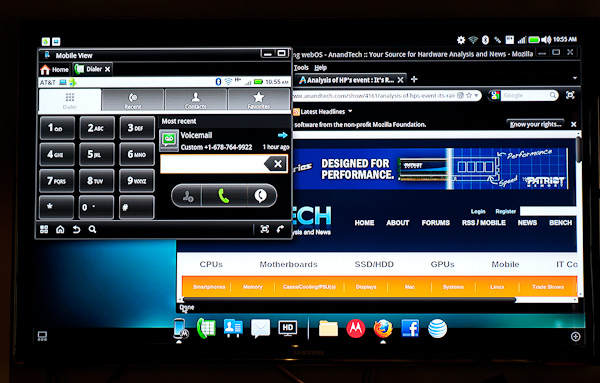
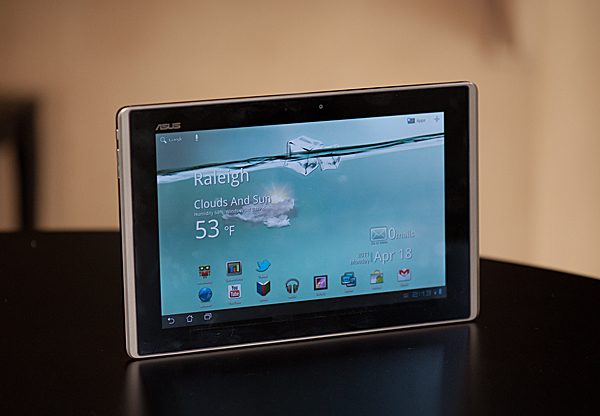
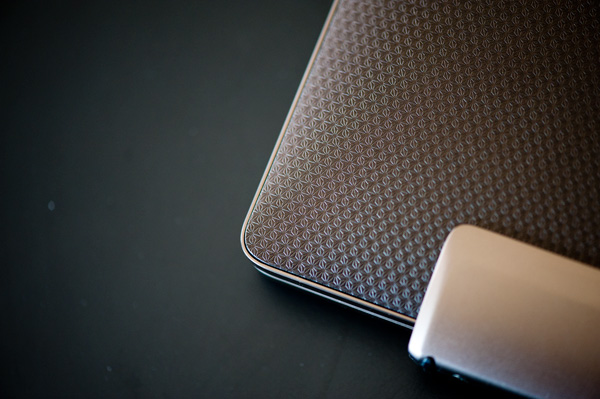
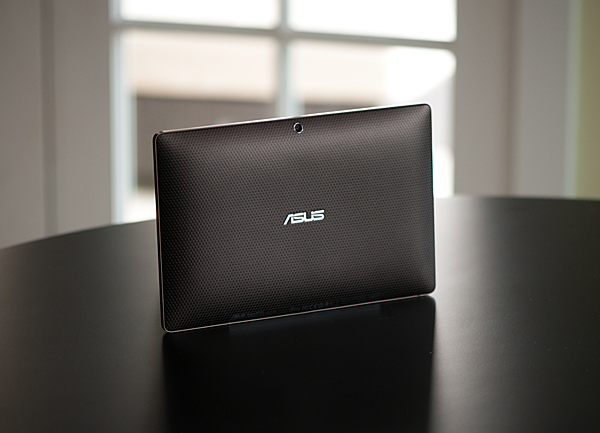
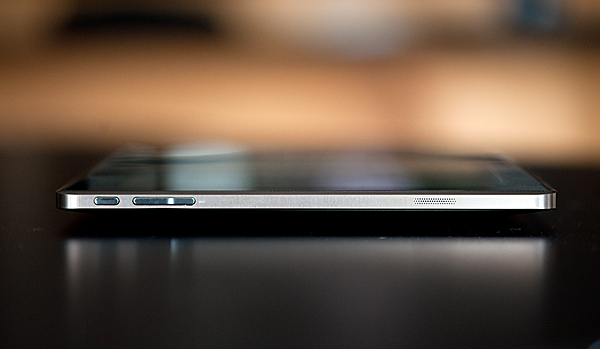

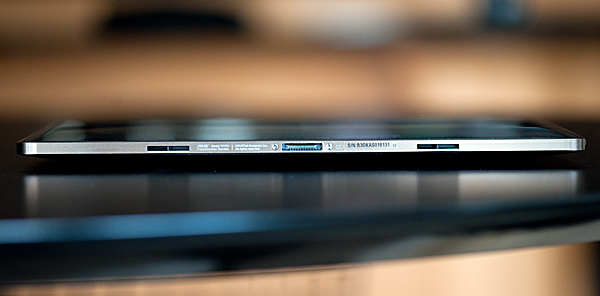









127 Comments
View All Comments
bplewis24 - Friday, April 22, 2011 - link
I believe they are introducing 3G models later in the year.Brandon
ubuntukungfoo - Friday, April 22, 2011 - link
This device is pure sex as far as I'm concerned. I would probably leave my gf for it if the situation was right. I'm not one of those people that want a 20" desktop replacement laptop. That's never really been my idea of mobile. The screen size doesn't reflect any increase in other personal measurements either. I have no need to overcompensate though so, 10" of screen real estate is actually perfect.With mobile it's always been battery life for me. The 16 hour battery life just kills everything else in my view. It has just enough computing power for casual use. If I want to do major computer stuff, I'll do it from my main desktop workstation or I'll use this as a terminal for virtual environments.
As far as desktop computing on the go, I'll just VNC, NX or even RDP over SSH into one of my dozens of VMs living in the cloud. The fact that this has some basic desktop functionality built in with honeycomb impresses the F out of me. If it ends up implementing the Batman protocol or some other mesh networking technology this could be the standard issue recommendation for everyone I know or do work for. This is everything the atrix wanted to be and more. I will be buying the keyboard and I think when you take into consideration it extends the I/O and battery life it's a must have and well worth the extra. How much does an apple bluetooth keyboard cost anyway and that battery can't be used by the ipad2.
However, it would be nice if there was a bundle price rebate if you bought both at initial purchase get $40 back or something. It should cost more for people that don't know what they want. Having a separate keyboard also solves a problem that's often bugged me about conventional notebook/netbook computing. If something goes screwy with either your keyboard or display you're kinda screwed. This thing affords me some level of modularity which I like ALOT!
Overall, for $550 price point for the complete experience I could certainly get a more powerful netbook or even notebook. For that matter I could build a massively powerful desktop computer. That's not the point here, and people that don't get it probably won't get it. Keep your storage and computing power in the cloud, it's much more economical on that level. It's all going that way anyway. Just look at what Apple is doing in NC. I already have dropbox, amazon cloud storage, EC2 and Asus even acknowledges this by including one free year of unlimited cloud storage with the device.
The truth is most people don't come close to tapping the full computing power of their desktops anyway. The lowest cost i7 processor is more than capable of running 24 separate virtual machines of various platforms concurrently with the right configuration. I do this for school systems on a budget all the time. I'll just tell them to buy transformers rather than thintops for each seat. The cost is really pretty comparable.
My iPhone got bricked with the iOS 4.3 update and I took it to the apple store so they could manually reload the firmware with their special tools. While I was waiting in line I got to play around with and ipad2 and a macbook air. I'm no apple fanboy but I was all but sold on getting one of those, that is until I found out about the transformer on the linux action show. This is actually kinda both and ipad2 and a macbook air in one if you think about it for a third of the cost.
Asus seems to get it, although by their advertising they don't understand the American market very well. The enthusiasts, the ones that will really be passionate about this product just need detailed hands on reviews to be sold on it. This review on Anandtech just solidified everything I already felt. The lay person, the non-apple brainwashed masses just want to know that it's polished, quick, easy and $100 cheaper than the iPad2. The techy people already know everything that's obvious about it and just want the nitty gritty details.
In regards to the android tablet competition out their, even other Asus tablet lines, don't even bother. That galaxy tab is a nice little form factor but there's not enough screen real estate to justify the cost. It's also not much bigger than my friends droid phone. The xoom is just too expensive and it's not very intuitive. It took me about 2 mins to locate the power button, and I'm no slouch. LOL I have high hopes for the Asus Eee pad transformer t101 and I'm sure the t102 will be even better. I'm sold!
ECTechSupport - Friday, April 22, 2011 - link
You can also resolve this problem with a Citrix environment and using a device that has the Citrix Receiver installed."The problem is as follows: if I'm on my desktop with half a dozen tabs open and perhaps a PDF as well, but I decide to switch over to a tablet—there's no quick way that I can transition my reading environment between the devices."
CharonPDX - Friday, April 22, 2011 - link
I got an iPad for my wife. After a week, she decided it wasn't something she'd use. (She is a stay-at-home mom, and her laptop works just fine for her.)I played with it a little, but didn't really think it could replace either my (aging, due for replacement) laptop or my mobility-is-all netbook. Then I saw a coworker's hard-sided aluminium keyboard case. (Zaggmate, for those that are curious.) That sold it. I now haven't used my netbook in months, the iPad+keyboard is smaller and can do more; and my laptop has been relegated to "small desktop computer" status. (I also have a dual-socket workstation at my desk, but it's so loud, I usually use the notebook.)
It achieves essentially the same form factor as the EeePad Transformer. And I love it. I can nearly guarantee that whenever I replace this iPad, it will be with a similar paired device. If the EeePad Transformer had been out when my wife poo-pooed the iPad, I likely would have returned the iPad and gotten the Transformer.
Your 'value' judgment on it is odd, though. You make a big deal out of the $100 cheaper the Eee is over any other tablet, then balk at the $150 keyboard. Pretty much any keyboard case for the iPad is $100. The extra functionality of this case is easily worth the extra $50! (I'd love to have the "iPad Camera Connection Kit"'s SD card slot built in to my keyboard along with a 50%-extra-life battery!) Even with the keyboard, it's then only $50 more than a few other tablets, and STILL cheaper than the Xoom.
If you have *ANY* use at all for a keyboard on the go, if you were even SLIGHTLY considering a netbook or a low-end notebook to go with your tablet, this is an AMAZING value.
Zingam - Saturday, April 23, 2011 - link
Finger prints festivalkasplat - Sunday, April 24, 2011 - link
If they supported SDHC then you could store so much more and the storage would be faster and cheaper. Is the microsd really saving that much space or money? The Apple dongle approach almost makes more sense except that in Apple's case you can't really use the storage via the camera connector kit as extra storage, just for transferring.HTC Fan - Monday, April 25, 2011 - link
I registered just so I could comment how great I thought your review was.This is probably the best tablet out there you can get for a very competitive price. You did mention that the docks does cost a lot but I think it is worth it for extra battery life and for versatility, and even with the $150 it is STILL cheaper than the cheapest XOOM.
I am waiting for the Samsung 10.1 as I do want a lighter tablet, but if that thing wasn't announced I definitely would have gotten this.
antoniolicon - Monday, April 25, 2011 - link
My imagination is stirred by your mention of 'device synergy'. It reminds me of an article I read in Gizmodo: http://www.engadget.com/2010/05/26/a-modest-propos...I have this mad idea that in our glorious future we will be able to dock these mobile devices (maybe even wirelessly!) and expand our processing, gpu, and ram much in the same way we can attach a keyboard, mouse, or monitor.
Maybe offices will contain a cpu room that distributes processing power out to my phone or tablet at my desk.
Airports and cyber cafe's might offer processing power in much the same way they offer wi-fi.
Crazy, right?
BTW, I would love to see a benchmark comparison of the iPad2 vs the acer w500 and it's ilk. I am hoping to see (this year!) a netbook killer tablet that runs a serious OS. OSX, Windows, or Linux (Ubuntu Tablet Remix would be great!)
Thanks,
Antonio Licon
http://ffwd.typepad.com
hldc1 - Monday, April 25, 2011 - link
Does anyone know if you'll be able to use a 3G/4G USB modem/data stick (from Verizon, T-Mobile, etc.) with the Asus Transformer?JBT - Monday, April 25, 2011 - link
I've heard if you buy them together the keyboard is only $100 rather than $150.